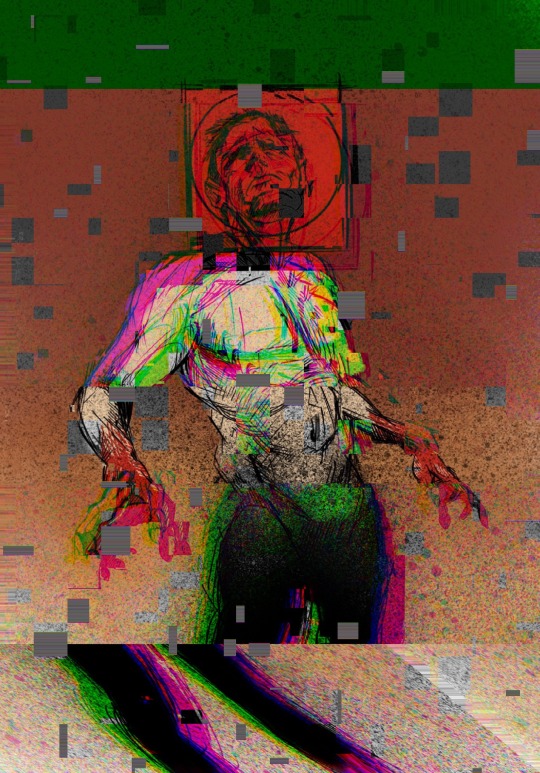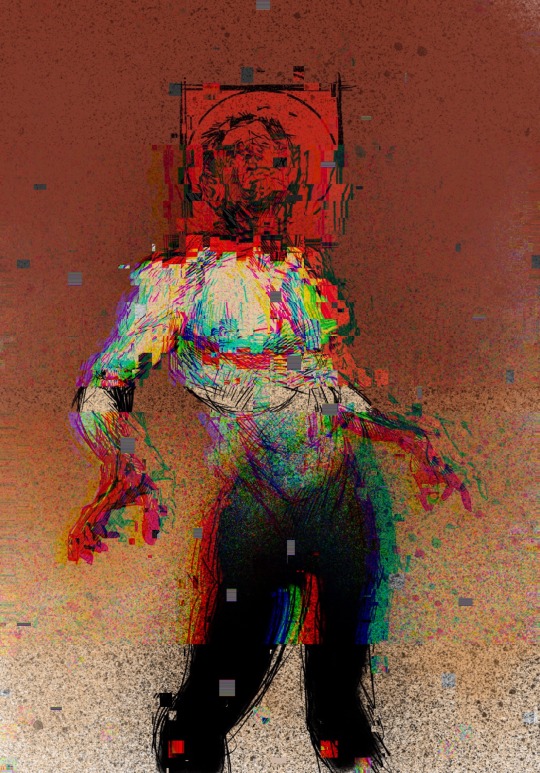Link
Example of Glitch artifacts used in music. The albums title translates into “Dark Piano”. This is apt, as the music is very atomspheric, and casts deep shadows. the piano is manipulation through electronic production, so the notes can be warped and blurred, creating a somber, tentative, dreamlike world. An example of glitch, a disruption of information, in this case vibrations that can be felt more keenly through the ghosts in the machine. The notes bleed, into eachother and into the atmosphere.
4 notes
·
View notes
Text
Cubism
Since the Renaissance, painters in Europe used techniques such as single point and linear perspective to bring their work a sense of depth and realism. This suggests three dimensional form within scenery and still life. Its precision in angles and vanishing points fails to represent binocular vision of our eyes. The work of the Cubists was a radical break from these traditions. Working from the inspiration of Cézanne, Cubists broke up their subject matter into geometric shapes or planes. These fragmented marks make up the subject matter, often bringing together different viewpoints within the same image. This bring a completely different idea of spatial and temporal orientation. In these images, space collapses in onto itself. The Cubists are aware of the aspect of illusion within the act of painting, of bringing three dimensions to the flat space of a canvas. Forms are compressed, splintered, fractured, as they are when viewed by our eyes. The images relationship to time also changes. More traditional techniques use the idea of working from a single fixed, unmoving viewer in space, whereas within cubism, multiple viewpoints are compressed into one, creating the impression that the viewer is moving through space. This maybe a more organic human way to present objects or scenes. The structure of an image seen is itself very political, or at least ideological. Images shape how see see the world, how we experience space and time. There is a shift, from art defining taste or beauty, to art reflecting life, how we experience reality and images. This work reexamines our relation to the world, with all our preconceived notions of beauty. Through deconstruction, through fragmentation, the notions of art history and the perception of human life is shifted and becomes new again.
Synthetic Cubism evolved from the early ideas, called Analytic Cubism. This was characterised by the introduction of collage, allowing new explorations of depth and the idea of the found object. Using printed paper fragments, sheet music, newspapers, in the work of the Cubists marked the first use of collage in fine art. The idea behind it was that art could be found in the chaos of everyday life. The idea of the fragment is key in the work of the Cubists, within representation of form and the material often introduced in work. Deconstruction is key to examining or re-examining how an image can be built. In order to. To embrace fragmentation is to embrace spontaneity, disruption, chaos, incompleteness, a revealing of the illusions of depth.
0 notes
Text
Glitch Art
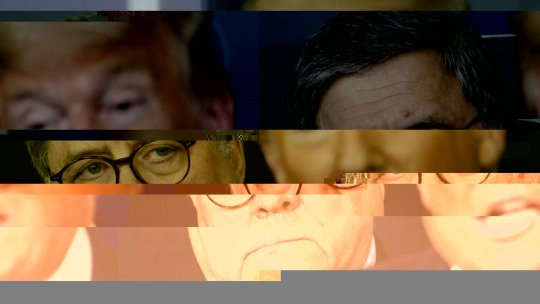
Glitch art can be defined as the practice of manipulating technology through processes to produce unexpected images or sounds. Manipulating data, corrupting code, or alternative uses of hardware to introduce an element of randomness and chance into to production of art. Working with code in this way is a destructive means of creation, as opposed to a constructive one. The practice seeks to make familiar forms unrecognizable, as opposed to artmaking that makes images appear, as with printing or drawing. It is in itself, a form of abstraction. Glitch art exploits the instability of technology and harnesses failure as a creative tool to corrupt the familiar. This has potential to explore political ideas. The renderings I have made are uncertain and indeterminate. These methods when explored with the addition of traditional art making methods, explore the juxtaposition of the importance of medium, the relationship with low culture and high art concepts, and engage with the digital-physical self.
DATABENDING
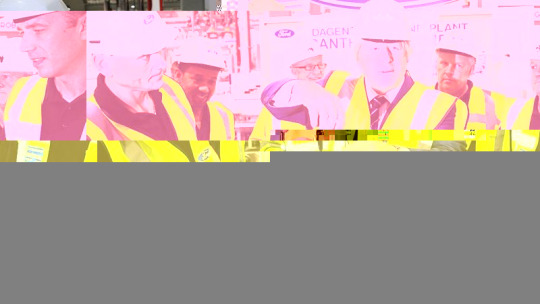
This is the practice I have utilised to produce these images. It is the practice of damaging digital image files by deleting, rearranging and duplicating the file’s text code in order to produce a corrupt image.
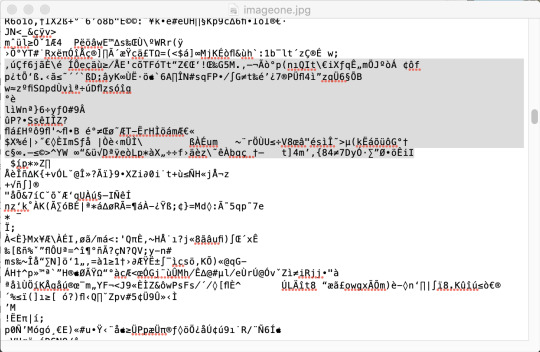
This is how the photo appears when converted from a .jpg file to a .txt file. After “bending” the code, I save it back into an image format, rendering a visual glitch. This is a simple process that I did not need any special software to do. It is however, by its very nature a random process. I have no Idea what visual information is stored in which areas of text. Glitching the code can be tedious, and sometimes the image’s code will be corrupted to the point of total destruction.
0 notes
Text



I’ve become interested in digital glitching images using TextEditor. After which, I turned them into animated Gifs.
0 notes
Text
“The Majesty of Desolation”: Ryoji Ikeda’s Digital Sublime (Extract)
The following is a short extract from upcoming new work with Kerb Journal.
vimeo
“The limitlessness once found in nature gives way, in technology, to a limitlessness produced out of an idea which is not interested in being an idea of nature, but one which replaces the idea of nature.” – Jeremy Gilbert Rolfe
In 2013 Japanese born, Paris based artist Ryoji Ikeda exhibits Test Pattern (No.5) at Sydney’s Carriageworks. The warehouse-like interior is recast with a tapestry of binary information. These are not randomized projections, but rather reams of digital data, the kind of information increasingly invisible to us, given a fleeting physical form. Audible modulations effect an even greater disorientation, a speckled staccato static of foreign knowledge. Undulating lines of data spread through the space with an immersive, monochromatic liquidity, enveloping both architecture and audience. The rapidity of the projection creates a zoetrope of disorientation, like a scene from the window of a speeding car, a subterranean nightclub, a haywire LCD screen.
In this precarious impermanence there are stark and confronting referents to the objective world. In all its digital form, this is a site of mountains, oceans, canyons and torrents, collapsing and rising again into skyscrapers, stock exchanges, global cityscapes. It is impossible to retreat to the edges of the scene, to gain a critical stance or point of reference. The subject is enveloped in a moment outside of time, too much in the spasms of its immediacy to comprehend broader ramifications. There is a deeply captivating yet fundamentally unsettling sensation at work. This is the digital landscape.
Here, Ikeda offers a digital ontology, transmuting the data that silently thunders through our laptops, smartphones and internet connections into audiovisual projections, soundscapes and performances. Whilst the digital world is increasingly governed by big data, the “digital sensors, computer networks, data storage, cluster computing systems and cloud computing facilities”, these flows of information are becoming increasingly covert, ever more invisible. As Donna Harraway contends, “Our best machines are made of sunshine; they are all light and clean because they are nothing but signals, electromagnetic waves, a section of a spectrum.”
In Ikeda’s shift from clandestine to clarity, the artist mounts a challenge to the most fundamental dualisms that act as the axes to our digital topography. Nature and technology. Object and subject. Immediacy and duration. Surface and depth. Naturalization and aberration. Pleasure and terror. It is this collision, the challenge to comprehend the magnitude and immenseness of the digital, that places Ikeda in the lineage of the Sublime…
2 notes
·
View notes
Text
The theme of Week Seven is Dust and Debris. A good start is to research artists who’s work invoke this theme:
• Christine Borland: “After a True Story: Giant and Fairy Tales” The outline of two skeletons is shown, created in dust, through which a light is shone. It casts a shadow onto the wall behind

• Cornelia Parker: Her work evokes ideas of process and the transformation of objects through destruction, reconfiguration and resurrection. This relates rather well to the concept of Dust and Debris
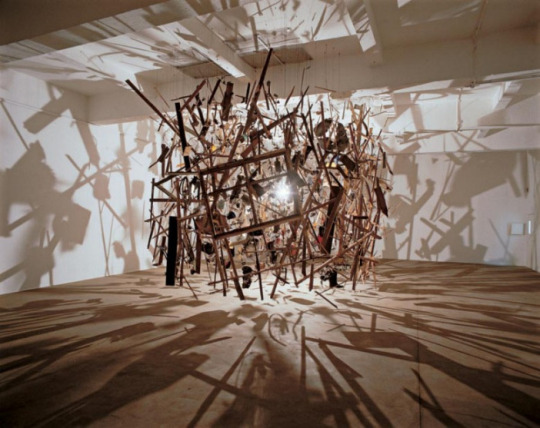
• Formless: A User’s guide; The words dust and debris do evoke the idea of the deconstructed remains of something that once had a form, the states of matter that are less than. But, they are still forms
• Jacques Ranciere’s writing on Modernism in literature, show his search for the equivalent for literature for what Turner is for Hito Steyerl: The beginnings of the modern period. “the moment when one set of ideas or beliefs that characterise a historical period are beginning to seem less certain”
• Kurt Schwitters, makes work out of rubbish found in his pockets. Rubbish can be associated with debris. Something leftover, devalued
• Georges Perec: his writing maintains the fragmentary quality of thought. The word fragment relates to dust and debris, a deconstruction, or a lack of form
Dust and debris creates the idea of a lack of intrinsic value. An artwork relating to this creates a value, or a juxtaposition/ subversion of expectation. A question is raised about what counts as art. Events of destruction or degradation . And the idea of formlessness.
0 notes
Text
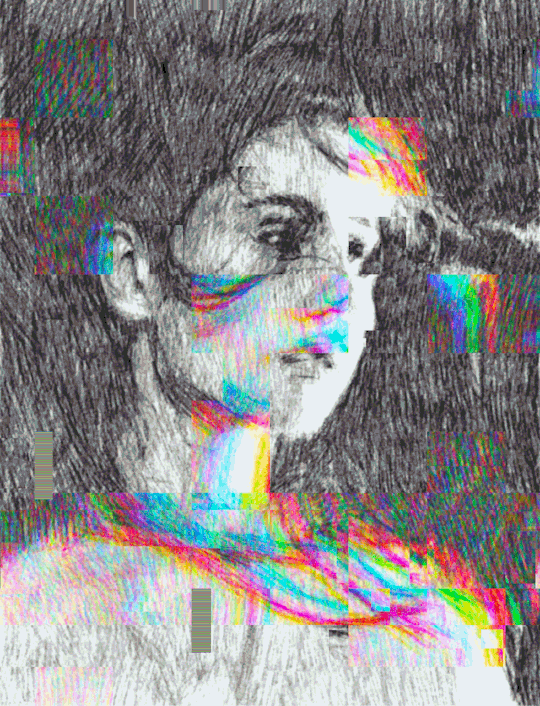
An animated if I made. I’m interested in the idea of replicating digital language by hand. Here I have done so through pencil and digital editing.
0 notes
Text
The Far Future
La Franais explores that speculative thought of imagining a future without humanity, possibly to inspire a desire for action on climate change
• Eugene Thacker, In the Dust of This Planet, and the “horror of philosophy”
• What happens to thought when we approach ideas our minds are not capable of thinking about, one of those being the world without humanity
• When confronting climate change, there could be a failure on a cognitive level, a failure of imagination
• If we could imagine the coming catastrophe, could we act faster
• We cannot comprehend our non existence
• The science is clear but our resolve is not, on either political or personal levels
• Thaker believes this comes from a deeply held belief that the environment is a resource for us to exploit
• Humans are really good at exploiting things
• How to rid ourselves of this thinking?
• Thaker believes it is necessary to conceptualise the world-in-itself
• Where humans are not in charge
• The Gaia Theory
• The world and its systems are an organism in their own right
• Gaia is the greek goddess of Life- mythology is fun
• The blue planet photograph
• Is this theory too anthropomorphised, idealising the earth as a nurturing mother protecting the human race
• Homeostasis doesn’t depend on humanities survival
• I think of us more as a parasite living on the earth, destroying it
• The idea of world-without-us instead of world-in-itself
• Thinking about the future demise of humanity involves projecting human thought into the future, were still marking it as human
Thaker’s solution-What if the thoughts we assume are human don’t actually belong to us at all?
• We are composed somewhat of other lifeforms, bacteria and fungi
• What if the contents of our minds are also non-human or comprise other beings
• Thought is not human
• The feeling that our thoughts don’t belong to us, that they are not human
• Certain patterns of thought don’t seem to be operating in our best interests
• Insomnia
• Self destructive thought patterns
• Mortal risk due to extreme negative thought patterns
• Toxoplasmic Gondii
• An organism that changes thought patterns in mice, causing it to be eaten, at the benefit of the pathogen
• The Far Future as a term directs us to think about it as remote
• Thakers point is that the-world-without-us is not far off
• In fact, can be a thought that is close at hand
• We need a mind full of thought entities that are not human
• Far future artists are ahead of the game
0 notes
Text
Contextualising Art: Far Future #3 Lecture Notes
What does it mean to contextualise art?
• Why the artist made that particular work, why was it possible or needed
• Why at this particular historical moment
• A matter of looking at the art of the past
• What precedents exist for the work in question
• Consider the work in relation with this
• Some art is an homage, some relations are unclear
• “Historic” Approach- cause and effect, assuming all work can be explained and contextualised by what comes before
• Some work does not follow this logic
• Sometimes tracking the origins or precursors of an artwork is difficult
• resistance to contextualising, some artists believing (arrogantly) that their work has no precursors
• Believing this denies the originality of the work
• An example in the article Deep time of the writer contextualising Katie Paterson’s work is by relating it to Joseph Beuys’ work.
• No personal relation hinted at in the piece
• Both artists are making work that is long term as to exceed their life expectancies: Beuys’ 7000 Oaks and Patersons Future Library
• Both feature tree-planting as a motif
• Theme of care and concern for the future generations?
• The writer’s remarks are brief about the two works, more of a basic equation
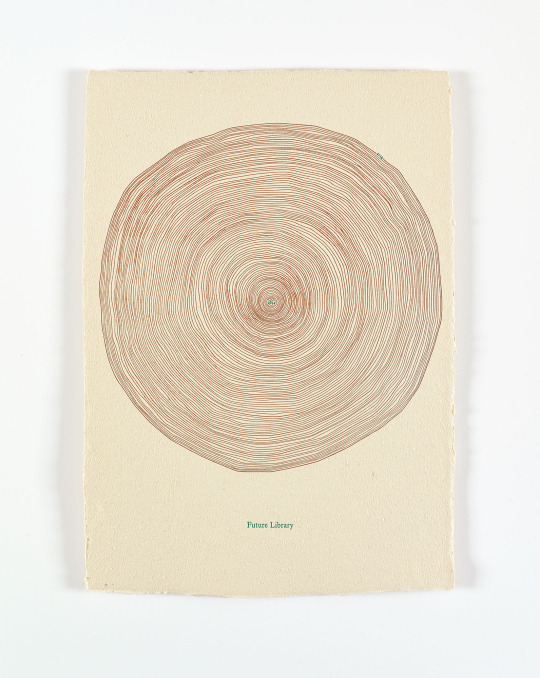
Joseph Beuy
• Performance artist
• The metaphoric values of materials
• Materials given personal significance with his own life: a part which also resonates with Paterson’s work
• The potential to contrast this with other artists approach with materials
• Artists for who the materials have no inherent value or meaning
• For example, Rodin would have used any clay to create his 19th century works, as long as it had the right consistency
• Contrast with Otobong Nkanga (I saw her work at Tate St Ives)
• Her samples are chosen from specific mines
• Cornelia parker
• Rachael Whiteread provides a more complex case: her material has significance in a general sense, however the use of polypropylene could have come from many sources, it not holding significance for the work itself
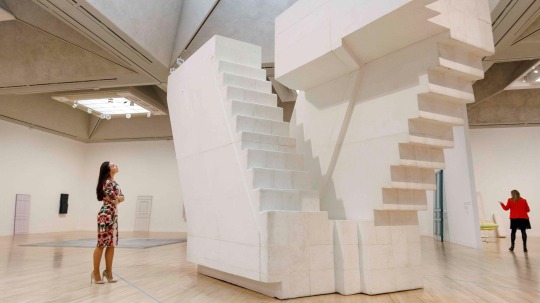
Another way of contextualising Paterson’s work is by Looking at her contemporaries, seeing how the culture surrounding her growing years shaped her work today
• Speculative
• Research into artist’s statements
• Simon Starling and Paterson both trained in Glasgow
• Both have an interest in “the explicit foregrounding of process” and an interest in the closed system
Paterson is also contextualised in relation to her own other work
• Moon – Earth – Moon
• The same foregrounding of process, challenge of scale and ambition, research, collaboration and realising unlikely ideas
• This work doesn’t evoke the idea of “deep time”
• But does relate an interest in astronomical distance
• What happens to though when it tries to grapple with something unthinkable

Longplayer by Jem Finer
• Similar to John Cage’s long scale musical pieces
• A performance that acknowledges the possibility of a world without humanity
• The intention is more of a positive hopeful one, that there would always be people around to listen
• The artists intention is to “engender a broader sense of how we consider and care for the future”
0 notes
Text
Texts I am reading and need to read
Glitch Poetics
Deep Time
Freefall: a thought experiment
Cartographies of the absolute
In the dust of this planet
Babbling ghosts: vaporwave
Nuclear futurism
0 notes
Text
• The contemporary image often features a breakdown of linear perspective
• Power/ assertion of dominance through perspective and the place of the viewer- the structure of an image shows the domination of culture, oppression and a lack of freedom
• Artists searching for the new and revolutionary in perspective
• Our brains seek out patterns and order, to give things structure- images that don’t follow this established form, that deliberately break the rules of the image and horizon could be more disturbing and catch our gaze mor
• Ideas of entropy, or chaos theory, a constant breakdown of forms within the visual arts, a tearing apart of representation itself
• The end of the church and noble patronage of the arts
• What is beauty today? What is the digital sublime? Nostalgia, uncanny/ plastic. is it still painting? is it found in images?
• Its data. Big data
0 notes
Text
Cartographies of the Absolute chapter one readings
• Short Film “powers of Ten” an exploration of the scale in the known universe
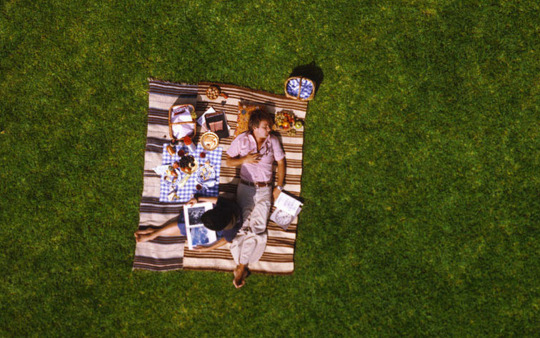
• “Toute La Memoire de Monde” an exploration of Frances Bibliotheque National and a meditation on human Memory and Knowledge
• Fredric Jameson says “the ultimate referent the true ground of being in our time, is capital”
• This I think links with Hito Steyerls explanation of freefall: I think capitalism is presented as the ultimate answer to our feeling of groundlessness.

• Another thing that links to Steyerls piece, the introduction of the Vertical perspective with the observation of technologies increasing ability to map the world in various scales. Cartographers map the world, astronomers the universe, molecular biologists map genomes and atomic physicists map the building blocks of everything.
• A shift into the world of “Big Data”
• A vertical exploration of scale, a “Gods eye view”
• This book is very complicated and hurts my brain. I think it’s talking about understanding society and its present state through the lens of this vertical mapping. It references the military and commercial technologies of google maps and gps.
• “surrealist map of the world”
• Laura Kugan
• The significance of the blue planet, dubbed the “last Universalistic icon”
• Ecologism, cultural liberation and technophilia, but also the danger of military and commercial satellites
• I got to Page 20
0 notes
Text
Hito Steyerl, Freefall
• Filmmaker, moving image artist, writer and essay documentarian
• Makes art about the digital world, art, capitalism and the impact of artificial technology on society
• In essence, how issues of power play out through the conventions of the image
• I think images are one of the most powerful forms of communication in our society today
• FREE FALL: to fall uncontrollably. Could be the value or price of something OR an object falling only under the speed of gravity. The object accelerates as it falls downwards
• Steyerls essay is about the contemporary moment being in a state of free fall. I believe her point is in past times our understanding of the world was based in something solid. Knowledge, fixed foundation. But now we are faced with a forced change in perspective. We no longer have those same certainties to give understanding. Are we freer, living in a society of less structure?
• Does this instability lead to a sort of emancipation?
• Can this link to the breakdown of traditions in the art world about what is classified as art?
• Do we now have the voice to shape the world according to our own creeds and beliefs
• Humans are born with two innate fears. A fear of loud noises, and a fear of falling
• What is the fear? Danger, imminent harm or death, or the feeling of uncertainty and lack of solidity? Or the speed of falling without resistance, without power.
• “temporary contingent, partial attempts of grounding” reminds me of a government attempting to maintain control and clear authority while being incredibly unstable and out of depth
• Sensory Tricks of orientation
• What is truth?
• What is “real” mean now? Who can we trust?
• The idea of an increasing popularity in extreme political ideas- fringe views gathering followers. In the information overload age people are desperate for grounding, for someone to have the right answers.
• They will allow themselves to become twisted, to assimilate the loudest voice screaming
• Her point is this: this contemporary state of being can be correlated to a predominance to a new kind of image of pictorial space, VERTICAL PERSPECTIVE
0 notes
Text
Some Notes on ”Deep Time” by Rob La Frenais from Art Monthly Dec 2018/Dec 2019
• Comments on the Climate Change Situation
• Pretty Stark “the planet will probably be uninhabitable in the lifetime of our grandchildren”
• What does this mean for long- duration artworks, if nobody will be alive to witness them
• “Deep Time projects”
• Joseph Beuy’s 7000 Oaks
• The Future Library: four books commissioned from authors, which will not be read in the writer’s lifetime
• John Cage’s 1987 work Organ2/ ASLSP (as slow as possible) will last for 639 years
• John Lathamn’s Flat Time Theory
• Long term projects engage with a “contract” or “legacy”
0 notes
Text
A few notes on my personal development form
Ideas and intentions
• the language of paint, examining the medium and its ability to effectively communicate and express intention, and the role of painting in a post internet environment.
• Working from found imagery and exploring the combination of low culture and high art concepts, and the visual quality of glitches and computer language
• questioning being witness to a constant stream of images and information and explore its psychological impacts on the way we see the world.
• Interested in atemporality, nostalgia, consumerism and the uncanny in the digital age
Forms and materials
• A combination of media
• Interest in the significance of the physical media such as painting and drawing when contrasted with more contemporary images
• Also digital media, such as manipulating images, exploring glitches and using found internet imagery
• Exploring different subcultures on the internet for example vaporwave, a microgenre of music and aesthetic emerging in the mid 2010s
Imagination and creativity
• I think the transition from physical mediums to digital ones, especially in the themes of art and studying it is relevant to everyone right now
• A personal challenge for me is how to present my work and ideas on an entirely digital format, and how to discuss ideas without face to face contact at uni
Critical reflection and evaluation
• Interested in a lot of digital artists such as Avery Spencer who combines digital design with painting
• Jon Rafman; the existential and social impact of technology on contemporary life
Personal development and professional studies
• Im interested in research as well as producing paintings, and I would like to develop my writing and critical skills, as well as writing as a form of artistic output
• I really like the writing of Hito Steyerl and her commentary on the status of the contemporary image
0 notes
Text
A summery and notes on Grafton Tanner’s book “Babbling Corpse: Vaporwave and the commodification of Ghosts”
Musings on the internet: Gives anonymity and pseudonymity, but also access to the private lives of anyone. There is a disconnect from the real people interacting with it. We are surrogates, avatars, a screen exists between us and our projections.Uncanny Valley.
The sensation of being a social being while being entirely alone, the disconnect from our physical bodies and their place in space. “invisible entities whose presence is felt yet who are wholly absent”
Here the author presents the idea of the twenty first century ghost, disembodied, removed from their corporal shells and set loose, travelling through the cyberspace with speed and precision. Nothing physical is there, the author reminds us, but the “dead gaze of the cp[y”
Laconian theory: the relationship of the subject and object through the gaze, this is disrupted by the false gaze of the internet.
The nature of these ghosts in our contemporary Western Culture. We are more disconnected from our physical environment then ever before. We have a stronger relationship with images and projections and the internet. These can be described as ghosts. Information removed and transmitted away from its original living presence. “ghosts of the past: remnants of history, trauma, memories, so much more in the information age.
De-centre the human as the locus of experience
Haunting are most frequent in twenty first century culture
At the centre of this is VAPORWAVE
An internet born electronic music micro-genre and aesthetic
Links to avent-guarde electronic musicians like John Cage
Emerged in the early 2010s
Ignored mostly by mainstream press, flourishing on sites like SoundCloud and reddit (underground appeal)
Vaporwave confronts themes of nostalgia, consumerism and the uncanny in a digital age.
“the musical product of a culture plagued by trauma and regression in late capitalism”
The internet is a place where longing for the past, fear for the future and dissatisfaction and disillusionment with the present mix
Critical of western cultures preoccupation with the past
Calls our collective regression into question
There are other artists who have this sensibility of vaporwave, they desire to turn our fascinations and fantasies into more disquieting forms, to suggest that all is not well and we have not been liberated in the internet age, screen saturated society
Artists who are skeptical of capitalisms promise to redeem us in the name of material goods and the nostalgia that hangs over an era obsessed with the cliches of history “modern culture and its sicknesses”
A state of atemporality, yearning for a time before the present, before the internet
Links 9/11 to the arrival of the twenty first century
Capitalism exploits our yearning for economic gain “commodifying the ghosts we clutch”
wipes away any meaning other than profit
The author comments on the arts ability to oppose these monolithic systems enslaving the west
Subversive qualities to vaporwave make us aware of the cultural issues that stunt political discourse and shun human empathy
Vaporwave is an alternative to the manufactured nature of the music industry another option to unfettered capitalism
0 notes
